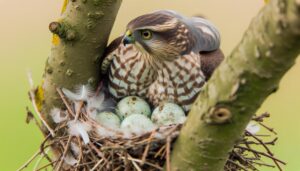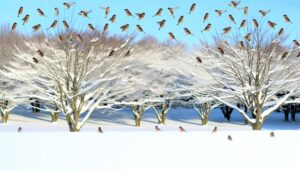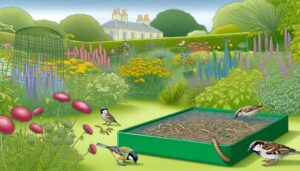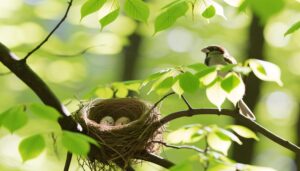Explain the Sparrow Hawk’s Diet in Its Food Chain
A sparrow hawk (Accipiter nisus) is an apex predator within its ecosystem, primarily preying on small birds like sparrows, finches, and tits, as well as rodents such as mice and voles. These prey species consume seeds, fruits, and various invertebrates like beetles and grasshoppers, which in turn feed on primary producers including grasses, shrubs, and flowering plants.
Sparrow hawks help regulate prey populations, maintaining ecological balance. Predators of the sparrow hawk include larger raptors such as goshawks and eagles, along with terrestrial mammals like foxes.
Understanding this dynamic reveals the intricate interconnectedness within food webs.
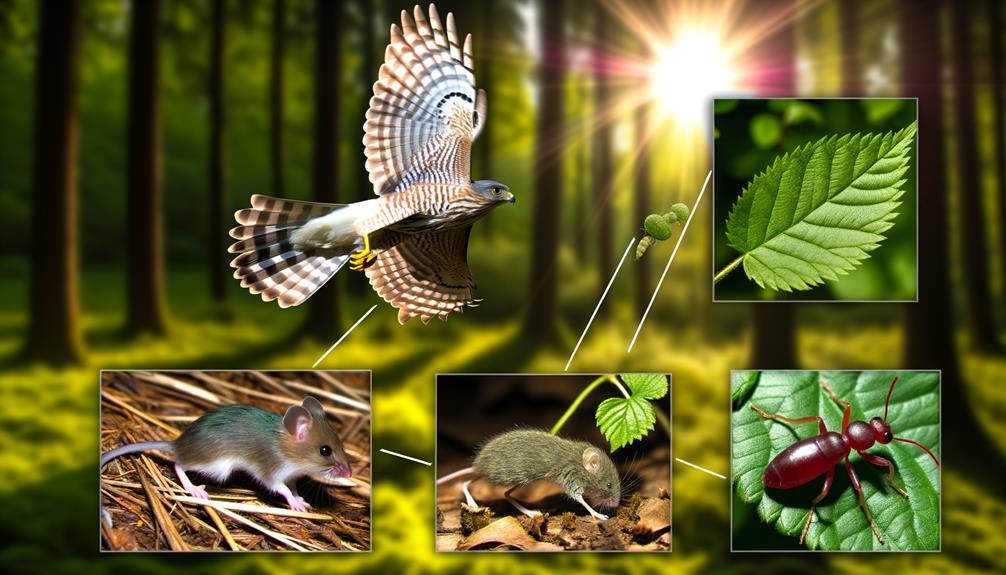
Key Takeaways
- Primary producers like grasses and shrubs convert solar energy into biomass through photosynthesis.
- Herbivores such as caterpillars and grasshoppers feed on primary producers and convert plant material into protein-rich biomass.
- Small birds and rodents consume seeds, fruits, and invertebrates, transferring energy up the trophic levels.
- Sparrow hawks hunt small birds, rodents, and insects, making them secondary or tertiary consumers.
- Larger raptors, mammals, and apex predators regulate sparrow hawk populations through predation.
The Primary Producers

The foundation of a sparrow hawk's food chain begins with primary producers, mainly comprising grasses, shrubs, and various flowering plants that convert solar energy into biomass through photosynthesis. These autotrophic organisms harness sunlight to synthesize glucose from carbon dioxide and water, forming the base of the ecological pyramid.
In ecological context, primary producers are essential as they generate the organic matter that sustains higher trophic levels. Their presence enhances soil fertility, supports microbial communities, and provides habitat structure. Detailed observations reveal that healthy populations of these plants contribute to a balanced ecosystem, ensuring a steady flow of energy and nutrients.
This balance is critical for the overall biodiversity, influencing the abundance and health of all subsequent trophic levels, including the sparrow hawk.
Herbivores and Insects
Supporting the sparrow hawk's food chain, herbivores and insects play an important role as primary consumers, feeding on the energy-rich primary producers. These organisms convert the solar energy stored in plants into consumable biomass, forming a pivotal link in the ecological network.
Key herbivores and insects in this scenario include:
- Caterpillars: These larvae primarily consume leaves, converting plant material into protein-rich biomass.
- Grasshoppers: Notable for their plant-eating habits, they greatly impact vegetation by consuming grasses and other flora.
- Beetles: Many beetle species feed on foliage, flowers, and roots, contributing to nutrient cycling.
- Aphids: These small insects feed on plant sap, affecting plant health and serving as prey for various predators.
Small Birds and Rodents
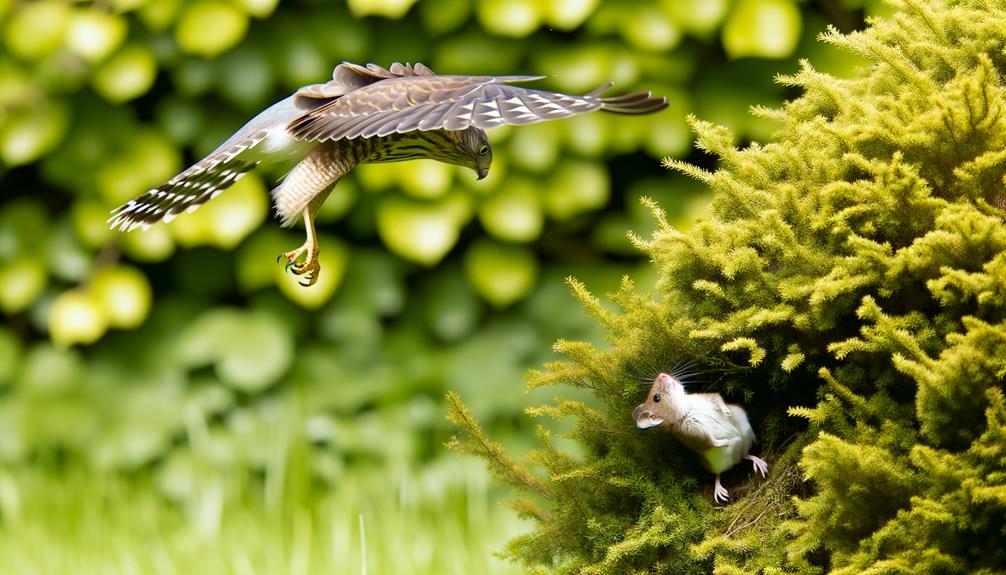
Essential to the sparrow hawk's diet, small birds and rodents serve as secondary consumers, transferring energy up the trophic levels within the ecosystem. These organisms primarily feed on seeds, fruits, and invertebrates, making them vital links in energy flow. By preying on these secondary consumers, sparrow hawks help maintain ecological balance, regulating the populations of these species and preventing overgrazing or overpopulation. The dynamic interactions between these prey and their surrounding environment highlight the complexity of food webs.
| Species | Primary Diet | Role in Ecosystem |
|---|---|---|
| House Sparrow | Seeds, Insects | Seed dispersal, Pest control |
| Field Mouse | Grains, Fruits | Soil aeration, Seed dispersal |
| Meadow Pipit | Insects, Seeds | Insect population control |
| Vole | Plants, Insects | Soil and plant interaction |
Understanding these relationships provides insight into the delicate balance within ecosystems.
The Sparrow Hawk's Diet
Sparrow hawks exhibit a highly specialized diet mainly consisting of small birds and rodents, which they expertly hunt and capture. This dietary preference is a critical component of their ecological niche, reflecting their role as adept aerial predators.
Key elements of their diet include:
- Small Passerines: Birds such as sparrows, finches, and tits form the bulk of their prey.
- Rodents: Mice and voles are frequently targeted, especially in areas with high rodent populations.
- Insects: During scarcity of primary prey, large insects like beetles and grasshoppers are also consumed.
- Occasional Reptiles: Small lizards may occasionally be part of their diet in certain habitats.
These dietary choices highlight the sparrow hawk's adaptability and predatory efficiency within its ecosystem.
Predators of the Sparrow Hawk

Despite their status as formidable predators, sparrow hawks are not exempt from the threat of predation themselves, facing dangers from larger raptors such as goshawks and eagles. These apex predators are known for their superior hunting prowess and often inhabit overlapping territories with sparrow hawks, leading to direct competition and predation.
Juvenile sparrow hawks are particularly vulnerable due to their inexperience and smaller size. Additionally, mammalian predators like foxes and domestic cats pose a significant risk, especially when sparrow hawks are nesting or roosting close to the ground.
Such predatory pressures contribute to natural population control mechanisms within their ecosystems, ensuring a dynamic balance among various trophic levels. Understanding these interactions is essential for comprehending the intricate web of food chain dynamics.
Ecological Impact
The presence of sparrow hawks within an ecosystem exerts a significant influence on the population dynamics of their prey species, which include small birds and mammals. This predatory behavior has several ecological ramifications:
- Population Control: Sparrow hawks help maintain balanced populations of small birds and mammals, preventing overpopulation and resource depletion.
- Biodiversity: By controlling prey populations, they foster biodiversity, allowing various species to coexist without one dominating.
- Health of Prey Species: They often target the weak or sick individuals, thereby promoting the overall health and genetic robustness of prey populations.
- Trophic Cascades: Their predation can influence lower trophic levels indirectly, affecting vegetation and invertebrate populations.
Such intricate interactions underscore the critical role of sparrow hawks in maintaining ecological balance.
Conclusion
The sparrow hawk, as a tertiary consumer, exemplifies the interconnectedness of trophic levels within its ecosystem. It relies on primary producers, herbivores, insects, and small birds or rodents, illustrating a complex food web.
This avian predator influences prey populations and maintains ecological balance. Predation pressure from larger raptors and environmental changes further impacts its survival.
Understanding the sparrow hawk's role underscores the intricacies of ecological dynamics, emphasizing the necessity for biodiversity and conservation efforts.

